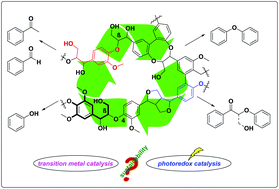Transition metal- and photoredox-catalyzed valorisation of lignin subunits†
Abstract
Lignin is a valuable source for chemicals, particularly phenols, and has the potential to serve as a raw material for fuels. Since lignin is a very complex molecule, it is very challenging to cleave bonds in lignin selectively yielding value-added chemicals. Over the years, several methods have been developed for lignin valorisation, e.g., pyrolysis, gasification, hydrolysis, hydrogenolysis, chemical oxidation etc. There has also been much advancement towards lignin valorisation by bioengineering and biorefining. In recent years, visible light photoredox catalysis has emerged as a powerful tool for construction and deconstruction of bonds. In this short review, we discuss three types of lignin depolymerisation methods, reductive, oxidative and redox neutral reactions, and compare the use of transition metal catalysis and photoredox catalysis in the transformations. We discuss the advantages and disadvantages of the two approaches.



 Please wait while we load your content...
Please wait while we load your content...